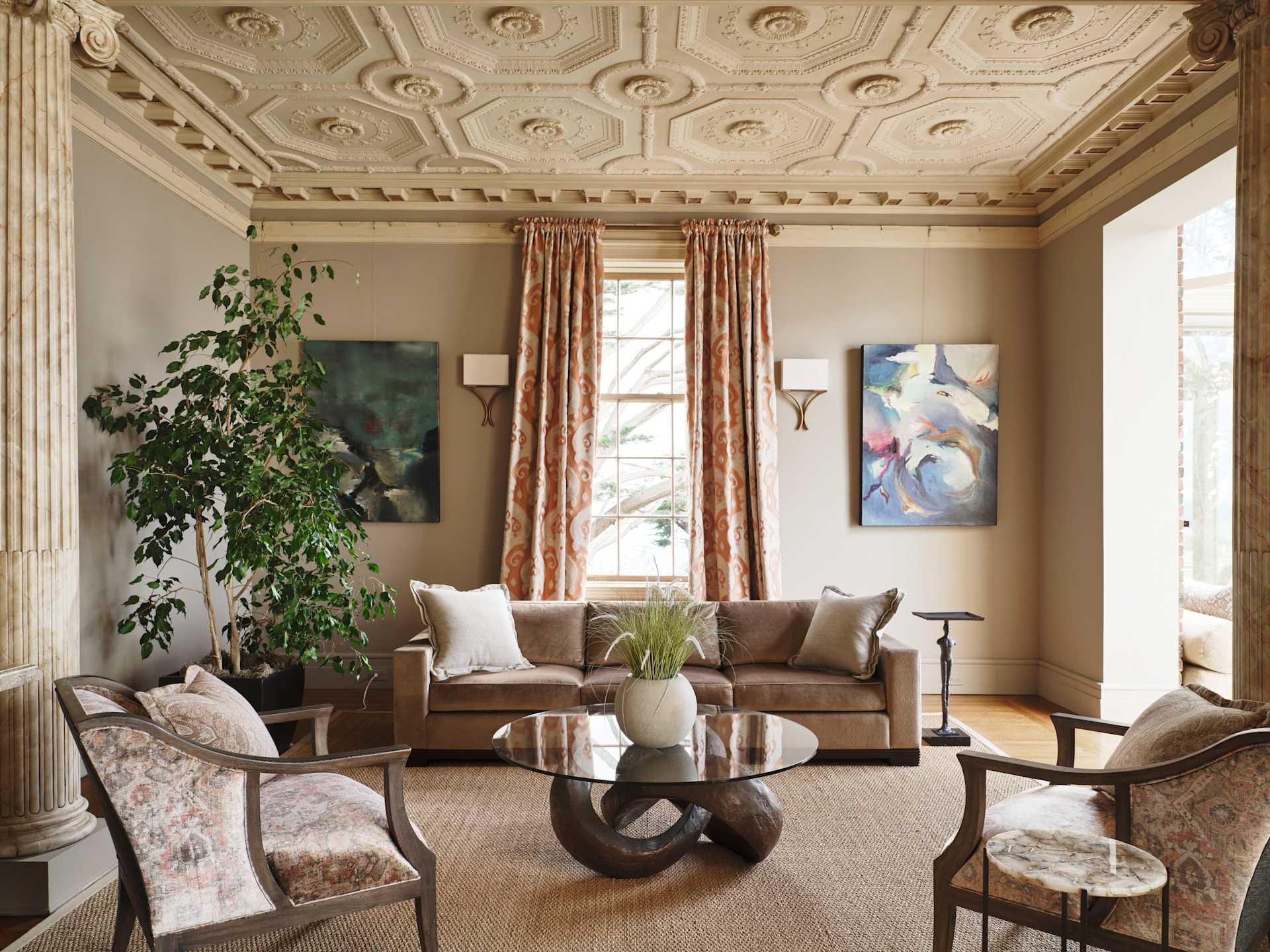E.B. Solomont REAL ESTATE REPORTER They may not be railroad barons or heiresses, but these homeowners appreciate the history and architecture behind these historic properties
Growing up in the 1980s, Chad Wyckoff always felt he should have been born a century earlier: He loved ballet, opera and historic homes.
So when he moved to Ohio from New York City a few years ago, he refused to look at homes less than 100 years old. In 2020, he paid $150,000 for a Colonial Revival built around 1906 for the president of a local varnish company. Located in the Dayton View Historic District, it has original stained glass windows, a tin ceiling in the kitchen and six fireplaces.
New construction homes are “generic” and lack personality, said Wyckoff, a 40-year-old marketing manager. “I loathe open concept.”
After replacing the home’s roof, electrical and HVAC and restoring the first floor, Wyckoff sold it this year for $210,000. Now he’s living in another Gilded Age home next door that he inherited from his late parents. “It’s a passion for me—I want to preserve any home or structure I can for future generations,” he said.
Over the past decade, Gilded Age homes have experienced something of a renaissance, with popular TV shows like HBO’s “The Gilded Age” sparking interest in grand homes built around the turn of the 20th century. Covid also helped boost the appeal of these homes, real-estate agents said, because they have large rooms that can be closed off to create distinct living spaces.
“You can’t have two, three, four people doing Zoom calls and schooling in a gigantic white box with no walls,” said Bonnie Spindler of Corcoran Icon Properties, who lives in a circa-1893 mansion in San Francisco.
But cavernous homes with vast entertaining spaces can place a heavy burden on owners responsible for their upkeep, agents said. Houses with intricate moldings and original millwork also tend to have leaky cast-iron pipes and knob-and-tube wiring.
“You really have to be invested in something like this, because if you have to restore or update it, it is a bit of a commitment, shall we say,” said Max Armour of Compass, who is currently marketing a San Francisco Gilded Age mansion for $32 million with colleague Karen Mendelsohn Gould.
Jackson’s St. Louis house is about 13,000 square feet. It is on a private street in the Central West End neighborhood. Karen A. Palmer for The Wall Street Journal
Historians generally describe the Gilded Age as the period of rapid economic growth between the 1870s through the early 1900s. Homes built during that time were designed to showcase the massive wealth and prosperity of their owners.
For affluent home builders of the era, “their homes were to demonstrate the enormity of their wealth and to assert the difference between their social stratum and that of the upper-middle class,” according to the 2009 book “Gilded Mansions: Grand Architecture and High Society.” “Architecture—in the form of the mansion—thus became a powerful symbol of a new layer in American society.”
Rather than a singular style, Gilded Age homes are known for extravagant materials and construction, including wood, stone and plaster work done by artisans. Common features include libraries, art galleries and salons, as well as sweeping staircases, sliding doors and ballrooms.
People who can afford to buy these properties today are often drawn to the built-in artistry and sense of history they convey, Armour said.
“It’s deeper than just being a status symbol,” he said. “It’s a sense of pride of ownership.”
Interior of San Francisco Gold Coast mansion. Brad Knipsten for Max Armour COMPASS
A decade ago, when attorney Russell Jackson relocated to St. Louis from New York, local real-estate agents tried, to no avail, to steer him to the city’s affluent suburbs. “I wasn’t going to just move into a condo or something modern,” said Jackson, who grew up in Missouri.
Instead, he landed in a roughly 13,000-square-foot mansion in the city’s Central West End neighborhood. Built more than a century ago for a tobacco heiress, it has a marble stairway and glass-and-bronze interior doors. Jackson bought it for $1.1 million in 2013 from the estate of philanthropist Lucianna Gladney Ross, whose father was a founder of the 7UP company, records show.
He has since spent about that much updating the house and decorating with a mix of art deco, antique and modern pieces. Over the years, Jackson, who lives in the house with friend Alex Gutierrez, said he’s hosted salons for professional musicians and Christmas parties. He’s even gotten to know Gladney Ross’s family, and said they’ve spent hours playing piano and singing together. “It’s fun to be part of the history of the house,” he said.
Gilded Age houses reflect a bygone way of life. When Patrick and Natividad Quinn bought a circa-1883 house in Hoboken, N.J., for $1.25 million in 2000, they discovered ornate doorknobs and finishes on the main entertaining floors that grew increasingly plain on higher floors, where staff would have lived. And in East Hampton, N.Y., a circa-1889 house has 12 bedrooms, which allowed extended family to gather each summer, said Carolyn Jabs, whose late mother-in-law owned the house for nearly five decades. Built-in bookshelves made it easy to detach from technology. “The next thing you know, people are reading on the front porch,” she said.
Kyle Shiroma and Gerhard Spillmann bought a circa-1909 house in Centerville, Iowa, for $425,000 in 2021. Grant Webster for The Wall Street Journal
Set on approximately an acre, the roughly 7,100-square-foot house has nine fireplaces. It is listed for $10.995 million with Elizabeth Wohl and James J. MacMillan of Brown Harris Stevens. Wohl said it is part of the Ocean Avenue Historic District, which includes about 15 of the area’s first summer cottages.
Kyle Shiroma, 52, and Gerhard Spillmann, 63, bought their circa-1909 home in Centerville, Iowa, for $425,000 in 2021. Known as Drake Hall, the roughly 13,000-square-foot house had been used as a retail space for years, so they set about converting it back into a residence, which they want to open up for small events, including garden weddings.
Shiroma, who produces the Los Angeles Pottery Show, said they were drawn to the home’s sturdiness and beautiful detail, along with the large scale of the rooms, including a third-floor ballroom with a separate entrance. The house has eight bedrooms, including three originally used for staff. “This house was made for entertaining—literally,” he said.
The couple said they are using historical photos and original architectural drawings to slowly restore the home. “Our motto is to restore, not remodel,” said Spillmann. “I don’t need to put my ego stamp on it.” They estimated the project will cost $1.2 million; so far they said they have spent about $180,000.
Shiroma and Spillmann started by undoing alterations from the 1960s. That included foundation repairs under the dining room and foyer, which required workers to jack up the floor an eighth of an inch at a time, Shiroma said. They said they are contemplating what to do with a 14-by-14-foot bathroom with floor-to-ceiling tiles on the second floor, since they are not sure if the cast-iron pipes leak. “We’re in that dilemma,” Spillmann said. “Do we risk a flood?” They still need to add a kitchen.
Andrew Martorano and his husband, Blake Reynolds, found bats in the attic of their circa-1910 home in Attleboro, Mass., which they bought for $615,000 in 2019.
Martorano, 39, who works for a healthcare consulting company, said the bats got into the roughly 5,100-square-foot house through an old-fashioned insulation system that vents air out through small openings in the eaves of the attic. They have since closed the holes and installed an internal vent that lets air out but prevents insects and birds from entering.
“The one thing you have to be aware of is, ‘What’s inside these walls?’” Martorano said. “Is it structural? It is horsehair? Is there nothing?”
Aside from the bats, Martorano said the six-bedroom house was in excellent condition with “old-world charm” when they bought it. But he and Reynolds still faced the onerous task of diverting pipes from the septic system to the city sewer line and replacing lead pipes outside the house. That involved digging up the driveway and lawn. While gut-renovating a first-floor bathroom, the couple found original blueprints for the house, which have been helpful.
He estimated they invested well over $200,000 into the home, which was briefly listed for $879,000 this summer. Martorano said they got a few offers but got “super emotional” about leaving, so they decided to stay.
“At the end of the day, you truly put in your blood, sweat and tears and your money—all of your money,” Martorano said. Still, “there is some type of comfort to think, ‘We did this. We’re good stewards of the home.’”
Once restored, Gilded Age homes can command a premium among buyers who appreciate history and don’t want to live in a modern box, real-estate agents said. Moreover, in major cities these homes are often located in prime locations.
For example, Armour said his listing in San Francisco, which was built before the Golden Gate Bridge was completed, sits on a corner lot a block from the Presidio, a national park site. The roughly 11,000-square-foot house has 10 bedrooms spread over five levels, with views of San Francisco Bay and the Golden Gate Bridge from every level. “The location that they picked 130 years ago, still to this day, is Numero Uno,” Armour said. “They could have picked any lot. They picked the prime one.”
TV shows like HBO’s ‘The Gilded Age’ have sparked interest in grand homes built around the turn of the 20th century. PHOTO: HBO
The Dutch Colonial-style house was built around 1900 for Duane L. Bliss, a Massachusetts native who followed the Gold Rush to California and later became a timber and railroad baron, according to the book “Tahoe Heritage: The Bliss Family of Glenbrook, Nevada.” It is currently owned by tech investor Jim Willenborg and his wife, Barbara Willenborg, who paid about $3.4 million for the property in 1988, records show.
Still, Gilded Age houses sometimes lack the modern conveniences buyers want.
Patrick Quinn said the fact that his five-story Hoboken house didn’t have an elevator was a major “detraction” when he and his wife decided to downsize a few years ago. They spent about $1.4 million to restore the roughly 5,250-square-foot house, which they bought for around $1.25 million. After listing it for $5.25 million in 2017, they sold it for $3.5 million earlier this year with listing agent Jon Sisti of Corcoran Sawyer Smith. “I didn’t put an elevator in because I’d have to change too much of the inside structure,” Quinn said. “But I can’t tell you how many people looked at the property and wanted that.”
Wohl originally listed the East Hampton home for $11.5 million in February, but has since reduced the price. The house is very large and requires updates, she said. It doesn’t have air conditioning or a pool, and there are push-button light switches.
“It’s just for a very specific customer, which we know,” she said. “Not everybody is going to buy a house that’s over 100 years old.”
She said her marketing is “leaning into” the home’s historic status, to entice old-house lovers and make sure potential buyers know what to expect. For better or worse, she said, “when you walk into it, you just feel like you’re walking into another time.”
Many Gilded Age homeowners say the expense and bother are worth it for the features and history they love. Spindler, who paid $570,000 for her roughly 10,000-square-foot San Francisco mansion in 1995, said the upkeep on the property is constant. “It’s never over,” she said. But it’s worth it for the 12-foot ceilings, stained glass windows and elaborately carved woodwork.She bought the house “because I loved it,” she said. “Not because I thought I’d make money on it.”
Write to E.B. Solomont at [email protected]
Phone:
(415) 290-6058
Email:
[email protected]










